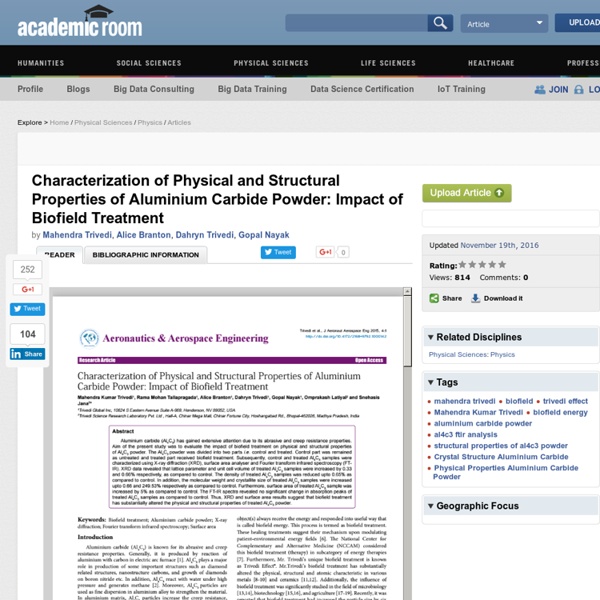



Spectroscopic Characterization of Disodium Hydrogen Orthophosphate and Sodium Nitrate after Biofield Treatment Open Access Trivedi et al., J Chromatogr Sep Tech 2015, 6:5 Research Article Open Access Chromatography Separation Techniques o u r n a l f h m t g p y e i c q s Volume 6 • Issue 5 • 1000282 J Chromatogr Sep Tech ISSN: 2157-7064 JCGST, an open access journal Spectroscopic Characterization of Disodium Hydrogen Orthophosphate and Sodium Nitrate after Biofield Treatment Mahendra Kumar Trivedi1, Alice Branton1, Dahryn Trivedi1, Gopal Nayak1, Khemraj Bairwa2 and Snehasis Jana2* 1Trivedi Global Inc., 10624 S Eastern Avenue Suite A-969, Henderson, NV 89052, USA 2Trivedi Science Research Laboratory Pvt. *Corresponding author: Snehasis Jana, Trivedi Science Research Laboratory Pvt. Bhopal-462026, Madhya Pradesh, India, Tel: +91-755-6660006; Fax: +91-755- 6660006; E-mail: publication@trivedisrl.com Received July 25, 2015; Accepted August 10, 2015; Published August 20, 2015 Citation: Trivedi MK, Branton A, Trivedi D, Nayak G, Bairwa K, et al. (2015) doi:10.4172/2157-7064.1000282 Abstract
Publication meta - Characterization of Physical, Thermal and Structural Properties of Chromium (VI) Oxide Powder: Impact of Biofield Treatment Chromium (VI) oxide (CrO3) has gained extensive attention due to its versatile physical and chemical properties. The objective of the present study was to evaluate the impact of biofield treatment on physical, thermal and structural properties of CrO3 powder. In this study, CrO3 powder was divided into two parts i.e. control and treatment.
Spectroscopic Characterization of Disodium Hydrogen Orthophosphate and Sodium Nitrate after Biofield Treatment Share this: Embed* Cite this: Trivedi, Mahendra Kumar; Branton, Alice; Trivedi, Dahryn; Nayak, Gopal; Bairwa, Khemraj; Jana, Snehasis (2015): Spectroscopic Characterization of Disodium Hydrogen Orthophosphate and Sodium Nitrate after Biofield Treatment. figshare. Retrieved 11:10, Oct 30, 2015 (GMT) *The embed functionality can only be used for non commercial purposes. Description Disodium hydrogen orthophosphate is a water soluble white powder widely used as pH regulator and saline laxative. Overall, the FT-IR and UV spectroscopic data of both compounds suggest an impact of biofield treatment on spectral properties with respect to force constant, bond strength, dipole moments and transition energy between two orbitals (ground state and excited state) as compared to respective control. Comments (0) Published on 03 Oct 2015 - 13:35 (GMT) Filesize is 728.17 KB License (what's this?) Cite "Filename" Place your mouse over the citation text to select it
Publication meta - Spectroscopic Characterization of Disodium Hydrogen Orthophosphate and Sodium Nitrate after Biofield Treatment Disodium hydrogen orthophosphate is a water soluble white powder widely used as pH regulator and saline laxative. The sodium nitrate is a highly water soluble white solid, used in high blood pressure, dentinal hypersensitivity, and production of fertilizers. The present study was aimed to investigate the impact of biofield treatment on spectral properties of disodium hydrogen orthophosphate and sodium nitrate. The study was performed in two groups i.e., control and treatment of each compound. The treatment groups were subjected to Mr. Trivedi's biofield treatment. Evaluation of Biofield Treatment Dose and Distance in a Model of Cancer Cell Death An Emerging Global Opportunistic Pathogen | Trivedi Science Abstract Stenotrophomonas maltophilia ( S. maltophilia ) is a Gram-negative bacillus, an opportunistic pathogen, particularly among nosocomial infections. Multi-drug resistant strains are associated with very high rate of morbidity and mortality in severely immunocompromised patients. Present study was designed to evaluate the effect of biofield treatment against multidrug resistant S. maltophilia . Clinical sample of S. maltophilia was collected and divided into two groups i.e. control and biofield treated which were analyzed after 10 days with respect to control. The following parameters viz. susceptibility pattern, minimum inhibitory concentration (MIC), biochemical studies and biotype number of both control and treated samples were measured by MicroScan Walk-Away® system. Keywords: Stenotrophomonas maltophilia ; Multidrug resistant; Antimicrobial susceptibility; Biofield treatment; Biochemical reactions; Biotyping Introduction Evaluation of antimicrobial susceptibility assay Table 1.
Biofield Treatment: An Alternative Approach to Combat Multidrug-Resistant Susceptibility Pattern of Raoultella ornithinolytica - Trivedi Science Abstract Raoultella ornithinolytica is belongs to the family of Enterobacteriaceae, a Gram-negative encapsulated aerobic bacillus associated with bacteremia and urinary tract infections. As biofield therapy is increasingly popular in biomedical heath care, so present study aimed to evaluate the impact of Mr. Trivedi’s biofield treatment on antimicrobial sensitivity, minimum inhibitory concentration (MIC), biochemical study, and biotype number of multidrug resistant strain of R. ornithinolytica. Biochemical reaction study showed 15.15% alteration in different biochemical such as cetrimide, cephalothin, kanamycin, and ornithine after biofield treatment as compared to control. Keywords: Raoultella ornithinolytica ; Biofield treatment; Antimicrobial susceptibility; Biochemical reaction; Biotype; Multidrug resistant Introduction Genus Raoultella belongs to the family Enterobacteriaceae, mainly contains Gram-negative, aerobic, non-motile, capsulated, and facultative anaerobic bacilli [1]. 1.
Impact Of Biofield Treatment On Salmonella Paratyphi A | Trivedi Science Abstract Enteric fever is a major global problem. Emergence of antimicrobial resistance threatens to render current treatments ineffective. Keywords: S. paratyphi A; Paratyphoid fever; Antimicrobial susceptibility; Biofield treatment; Biochemical reaction; Biotype Abbreviations MIC: Minimum Inhibitory Concentration; ATCC: American Type Culture Collection; NBPC 30: Negative Breakpoint Combo 30 Introduction Enteric fever is a major public health problem in India. Fluoroquinolone derivatives like ciprofloxacin, nalidixic acid etc. are extensively used to combat paratyphoid fever in most parts of world. Harold Saton Burr, had performed the detailed studies on the correlation of electric current with physiological process and concluded that every single process in the human body had an electrical significance [10]. Materials and Methods S. paratyphi A, American Type Culture Collection (ATCC 9150) strains were procured from MicroBioLogics, Inc., USA, in two sets A and B. Experimental design Gr. 1.